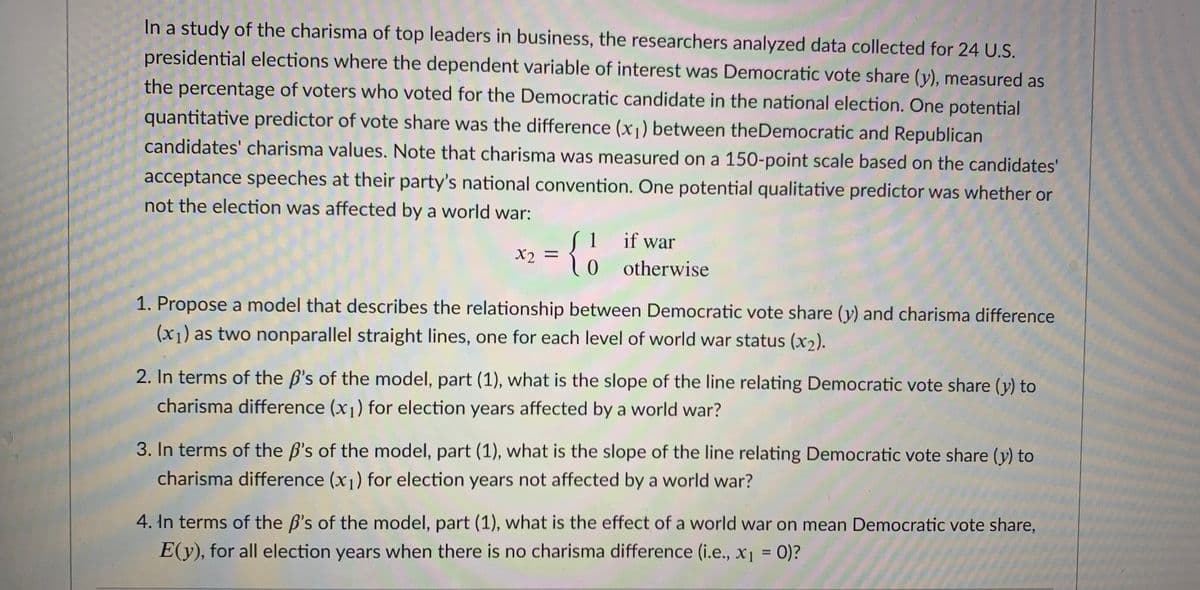In a study of the charisma of top leaders in business, the researchers analyzed data collected for 24 U.S. presidential elections where the dependent variable of interest was Democratic vote share (y), measured as the percentage of voters who voted for the Democratic candidate in the national election. One potential quantitative predictor of vote share was the difference (x1) between theDemocratic and Republican candidates' charisma values. Note that charisma was measured on a 150-point scale based on the candidates' acceptance speeches at their party's national convention. One potential qualitative predictor was whether or not the election was affected by a world war: if war
In a study of the charisma of top leaders in business, the researchers analyzed data collected for 24 U.S. presidential elections where the dependent variable of interest was Democratic vote share (y), measured as the percentage of voters who voted for the Democratic candidate in the national election. One potential quantitative predictor of vote share was the difference (x1) between theDemocratic and Republican candidates' charisma values. Note that charisma was measured on a 150-point scale based on the candidates' acceptance speeches at their party's national convention. One potential qualitative predictor was whether or not the election was affected by a world war: if war
Glencoe Algebra 1, Student Edition, 9780079039897, 0079039898, 2018
18th Edition
ISBN:9780079039897
Author:Carter
Publisher:Carter
Chapter4: Equations Of Linear Functions
Section4.5: Correlation And Causation
Problem 2AGP
Related questions
Topic Video
Question

Transcribed Image Text:In a study of the charisma of top leaders in business, the researchers analyzed data collected for 24 U.S.
presidential elections where the dependent variable of interest was Democratic vote share (y), measured as
the percentage of voters who voted for the Democratic candidate in the national election. One potential
quantitative predictor of vote share was the difference (x1) between theDemocratic and Republican
candidates' charisma values. Note that charisma was measured on a 150-point scale based on the candidates'
acceptance speeches at their party's national convention. One potential qualitative predictor was whether or
not the election was affected by a world war:
1
X2 =
if war
otherwise
1. Propose a model that describes the relationship between Democratic vote share (y) and charisma difference
(x1) as two nonparallel straight lines, one for each level of world war status (x2).
2. In terms of the B's of the model, part (1), what is the slope of the line relating Democratic vote share (y) to
charisma difference (x1) for election years affected by a world war?
3. In terms of the B's of the model, part (1), what is the slope of the line relating Democratic vote share (y) to
charisma difference (x1) for election years not affected by a world war?
4. In terms of the B's of the model, part (1), what is the effect of a world war on mean Democratic vote share,
E(y), for all election years when there is no charisma difference (i.e., x1 = 0)?
%3D
Expert Solution
This question has been solved!
Explore an expertly crafted, step-by-step solution for a thorough understanding of key concepts.
This is a popular solution!
Trending now
This is a popular solution!
Step by step
Solved in 5 steps with 5 images

Knowledge Booster
Learn more about
Need a deep-dive on the concept behind this application? Look no further. Learn more about this topic, statistics and related others by exploring similar questions and additional content below.Recommended textbooks for you

Glencoe Algebra 1, Student Edition, 9780079039897…
Algebra
ISBN:
9780079039897
Author:
Carter
Publisher:
McGraw Hill

Functions and Change: A Modeling Approach to Coll…
Algebra
ISBN:
9781337111348
Author:
Bruce Crauder, Benny Evans, Alan Noell
Publisher:
Cengage Learning

Big Ideas Math A Bridge To Success Algebra 1: Stu…
Algebra
ISBN:
9781680331141
Author:
HOUGHTON MIFFLIN HARCOURT
Publisher:
Houghton Mifflin Harcourt

Glencoe Algebra 1, Student Edition, 9780079039897…
Algebra
ISBN:
9780079039897
Author:
Carter
Publisher:
McGraw Hill

Functions and Change: A Modeling Approach to Coll…
Algebra
ISBN:
9781337111348
Author:
Bruce Crauder, Benny Evans, Alan Noell
Publisher:
Cengage Learning

Big Ideas Math A Bridge To Success Algebra 1: Stu…
Algebra
ISBN:
9781680331141
Author:
HOUGHTON MIFFLIN HARCOURT
Publisher:
Houghton Mifflin Harcourt